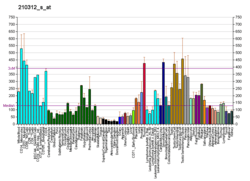IFT20
Intraflagellar transport protein 20 homolog is a protein that in humans is encoded by the IFT20 gene.[5] The gene is composed of 6 exons and is located on human chromosome 17p11.1. This gene is expressed in human brain, lung, kidney and pancreas, and lower expression were also detected in human placenta, liver, thymus, prostate and testis.[6]
Intraflagellar transport (IFT), in which molecular motors and IFT particle proteins participate, is very important in assembling and maintaining many cilia/flagella, such as the motile cilia that drive the swimming of cells and embryos, the nodal cilia that generate left-right asymmetry in vertebrate embryos, and the sensory cilia that detect sensory stimuli in some animals.[6] IFT20 subunit of the particle is localized to the Golgi complex in addition to the basal body and cilia where all previous IFT particle proteins had been found. In living cells, fluorescently tagged IFT20 is highly dynamic and moves between the Golgi complex and the cilium as well as along ciliary microtubules.[7] IFT20 has been shown to interact with SPEF2 in the testis, and plays a role in sperm motility.[8]
References
- 1 2 3 GRCh38: Ensembl release 89: ENSG00000109083 - Ensembl, May 2017
- 1 2 3 GRCm38: Ensembl release 89: ENSMUSG00000001105 - Ensembl, May 2017
- ↑ "Human PubMed Reference:".
- ↑ "Mouse PubMed Reference:".
- ↑ "Entrez Gene: IFT20 intraflagellar transport 20 homolog (Chlamydomonas)".
- 1 2 Yin G, Dai J, Ji C, Ni X, Shu G, Ye X, Dai J, Wu Q, Gu S, Xie Y, Zhao RC, Mao Y (December 2003). "Cloning and characterization of the human IFT20 gene". Mol. Biol. Rep. 30 (4): 255–60. doi:10.1023/A:1026365124176. PMID 14672413.
- ↑ Follit JA, Tuft RA, Fogarty KE, Pazour GJ (2006). "The Intraflagellar Transport Protein IFT20 Is Associated with the Golgi Complex and Is Required for Cilia Assembly". Mol. Biol. Cell. 17 (9): 3781–92. doi:10.1091/mbc.E06-02-0133. PMC 1593158. PMID 16775004.
- ↑ Sironen, Anu; Hanse, J.; Thomsen, B.; Andersson, M.; Vilkki, J.; Toppari, J.; Kotaja, N (2010). "Expression of SPEF2 During Mouse Spermatogenesis and Identification of IFT20 as an Interacting Protein". Biology of Reproduction. 82: 580–590. doi:10.1095/biolreprod.108.074971. PMID 19889948.
Further reading
- Andersson B, Wentland MA, Ricafrente JY, et al. (1996). "A "double adaptor" method for improved shotgun library construction". Anal. Biochem. 236 (1): 107–13. doi:10.1006/abio.1996.0138. PMID 8619474.
- Yu W, Andersson B, Worley KC, et al. (1997). "Large-Scale Concatenation cDNA Sequencing". Genome Res. 7 (4): 353–8. doi:10.1101/gr.7.4.353. PMC 139146. PMID 9110174.
- Strausberg RL, Feingold EA, Grouse LH, et al. (2003). "Generation and initial analysis of more than 15,000 full-length human and mouse cDNA sequences". Proc. Natl. Acad. Sci. U.S.A. 99 (26): 16899–903. doi:10.1073/pnas.242603899. PMC 139241. PMID 12477932.
- Baker SA, Freeman K, Luby-Phelps K, et al. (2003). "IFT20 links kinesin II with a mammalian intraflagellar transport complex that is conserved in motile flagella and sensory cilia". J. Biol. Chem. 278 (36): 34211–8. doi:10.1074/jbc.M300156200. PMID 12821668.
- Jurczyk A, Gromley A, Redick S, et al. (2004). "Pericentrin forms a complex with intraflagellar transport proteins and polycystin-2 and is required for primary cilia assembly". J. Cell Biol. 166 (5): 637–43. doi:10.1083/jcb.200405023. PMC 2172416. PMID 15337773.
- Gerhard DS, Wagner L, Feingold EA, et al. (2004). "The Status, Quality, and Expansion of the NIH Full-Length cDNA Project: The Mammalian Gene Collection (MGC)". Genome Res. 14 (10B): 2121–7. doi:10.1101/gr.2596504. PMC 528928. PMID 15489334.
- Rual JF, Venkatesan K, Hao T, et al. (2005). "Towards a proteome-scale map of the human protein-protein interaction network". Nature. 437 (7062): 1173–8. doi:10.1038/nature04209. PMID 16189514.




